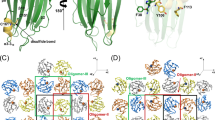Summary
The predominant host-selective toxin fromCochliobolus victoriae, victorin C, is a peptide with an apparent mol. wt of 796, representing a cyclic array of the subunits1–6. The structure of the toxin has now been established as in16 through analysis of the degradation products generated by enzymic and non-enzymic partial hydrolysis. The presence of a hydrated aldehydo group requires for victorin C the composition C31H45O13N6Cl3 with an amended mol. wt of 814, for which independent experimental support has been secured.
Similar content being viewed by others
References
Wheeler, H., and Luke, H. H., Microbial toxins in plant disease. A. Rev. Microbiol.17 (1963) 232–243.
Meehan, F., and Murphy, H. C., A newHelminthosporium blight of oats. Science104 (1946) 413–414.
Meehan, F., and Murphy, H. C., Differential phytotoxicity of metabolic by-products ofHelminthosporium victoriae. Science106 (1947) 270–271.
Scheffer, R. P., Host-specific toxins in relation to pathogenesis and disease resistance, in: Encyclopedia of Plant Physiology, New Series, Vol. 4, pp. 245–269. Eds R. Heitefuss and P. H. Williams. Springer Verlag, Berlin-Heidelberg-New York 1976.
Macko, V., Wolpert, T. J., Acklin, W., Jaun, B., Seibl, J., Meili, J., and Arigoni, D., Characterization of victorin C, the major host-selective toxin fromCochliobolus victoriae: structure of degradation products. Experientia41 (1985) 1366–1370.
For independent isolations of a toxic fraction fromC. victoriae which is probably identical with victorin C, cf. Keen, N. T., Midland, S., and Sims, J., Purification of victorin. Phytopathology73 (1983) 830 (Abstr.), and Walton, J. D., and Earle, E. D., Characterization of the host-specific phytotoxin victorin by high pressure chromatography. Pl. Sci. Lett.34 (1984) 231–238.
Chapman, G. E., Abercombie, B. D., Cary, P. D., and Bradbury, E. M., The measurement of small nuclear Overhauser effects in the1H spectra of proteins, and their application to lysozyme. J. Magn. Reson.31 (1978) 459–469.
Neuhaus, D., A method for the suppression of selective population transfer effects in NOE difference spectra. J. Magn. Reson.53 (1983) 109–114.
Fischer, G., Sieber, M., and Schellenberger, A., The carbonyl reactivity of 3-bromopyruvate and related compounds. Bioorg. Chem.11 (1982) 478–484.
Anderson, G. W., Zimmermann, j. E., and Callahan, F. M., The use of esters of N-hydroxysuccinimide in peptide synthesis. J. Am. Chem. Soc.86 (1964) 1839–1842.
1H- and13C-NMR data matching very closely the critical ones of victorin C have been reported for the hydrate of glyoxylylspermidine by G. A. Ellestad, D. B. Cosulich, R. W. Broschard, J. H. Martin, M. P. Kunstmann, G. O. Morton, J. E. Lancaster, W. Fulmor and F. M. Lovell, Glycocinnamoylspermidines, a new class of antibiotics: 3. The structure of LL-BM 123 β, γ1, and γ2. J. Am. chem. Soc.100 (1978) 2515–2524.
Author information
Authors and Affiliations
Rights and permissions
About this article
Cite this article
Wolpert, T.J., Macko, V., Acklin, W. et al. Structure of victorin C, the major host-selective toxin from Cochliobolus victoriae. Experientia 41, 1524–1529 (1985). https://doi.org/10.1007/BF01964789
Published:
Issue Date:
DOI: https://doi.org/10.1007/BF01964789




